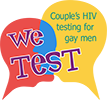
Protocol Number: ATN156
Title of Study: We Test
Project Leads: Tyrel Starks & Sarah Feldstein Ewing
Intervention Description: This study seeks to develop and examine the additive benefits of two adjunct components for Couples HIV Testing and Counseling (CHTC) specifically tailored for use with adolescent (aged 15-19) same-sex male couples. Adjunct components include video-based communication skills training viewed together by the couple before their CHTC session and individually delivered goals clarification and communication planning sessions conducted prior to completing CHTC together.
The multilevel emphasis of the study is reflected in the primary outcomes, which include four behavioral indicators of TRB. At the individual-level, they will examine: 1. number of CAS acts with a casual partner in the absence of PrEP (count distributed) and 2. any positive chlamydia or gonorrhea diagnosis in the absence of PrEP (dichotomous). At the couple-level, they will examine: 3. any sex in the absence of PrEP with a primary partner who reports CAS with a casual partner and 4. any sex in the absence of PrEP with a primary partner who receives a positive chlamydia or gonorrhea diagnosis.
Study Sites: Detroit, New York (Phase II). Detroit, New York, Miami, San Diego (Phase III).
Objectives: The primary goal is to optimize CHTC for use with adolescent-age (15-19 years) same-sex male couples.
Study Design: This is a comparative effectiveness trial (CET). Phase I (months 1-9) involves EPIS interviews with providers and youth to gather data which will inform implementation, as well as the filming of communication skills training videos and developing protocols for supplemental individual sessions. Phase II (months 10-24) will be a small RCT involving two ATN sites to evaluate the feasibility and acceptability of preliminary intervention packages (CHTC + videos; CHTC + videos + individual sessions; compared to CHTC alone). Phase III (months 25-36) will be a larger RCT involving 4 ATN sites comparing CHTC alone to the most acceptable and feasible treatment package identified in Phase II.
Number of Subjects: 36 couples in Phase II, 144 couples in Phase III
Criteria for Inclusion: Adolescent (aged 15-19) same-sex male couples
Study Results Coming Soon!

